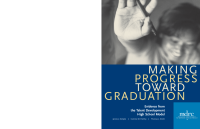Making Progress Toward Graduation
Evidence from the Talent Development High School Model
In low-performing public high schools in U.S. cities, high proportions of students drop out, students who stay in school typically do not succeed academically, and efforts to make substantial reforms often meet with little success. The Talent Development High School model is a comprehensive school reform initiative that has been developed to address these challenges. Targeting some of the most troubled schools in the country, the model seeks to raise the expectations of teachers and students and to prepare all students for postsecondary education and employment.
MDRC, a nonpartisan, nonprofit education and social policy research organization, conducted an independent, third-party evaluation of Talent Development. This rigorous evaluation focuses on the first five high schools to begin using the model in the School District of Philadelphia. The evaluation follows 20 cohorts of ninth-grade students for up to four years of high school using a comparative interrupted time series research design.
Key Findings
- Talent Development produced substantial gains in attendance, academic course credits earned, and promotion rates during students’ first year of high school. These impacts emerged in the first year of implementation and were reproduced as the model was extended to other schools in the district and as subsequent cohorts of students entered the ninth grade.
- Talent Development’s strong positive impacts during the first year of high school are consistent with the model’s intensive initial focus on the ninth grade and its emphasis on combining high-quality curricular and instructional enhancements with pervasive structural reforms aimed at building supportive and personalized learning environments.
- The improvements in credits earned and promotion rates for ninth-graders were sustained as students moved through high school. Improvements in student performance on the eleventh-grade state standards assessment began to emerge for later cohorts of students as the most intensive components of the model were extended beyond the ninth grade. There are also early indications that Talent Development is improving graduation rates.
The findings in this report provide encouraging evidence that real improvements can be made in some of the lowest-performing high schools in the country. Even with Talent Development’s substantial and persistent positive impacts, however, large proportions of the students in these high schools are not making adequate progress toward graduation. Moreover, because this evaluation focuses on Talent Development’s initial scaling-up effort in a single school district, it is not clear what would be required to produce the same effects in a larger number of schools or in other settings.






